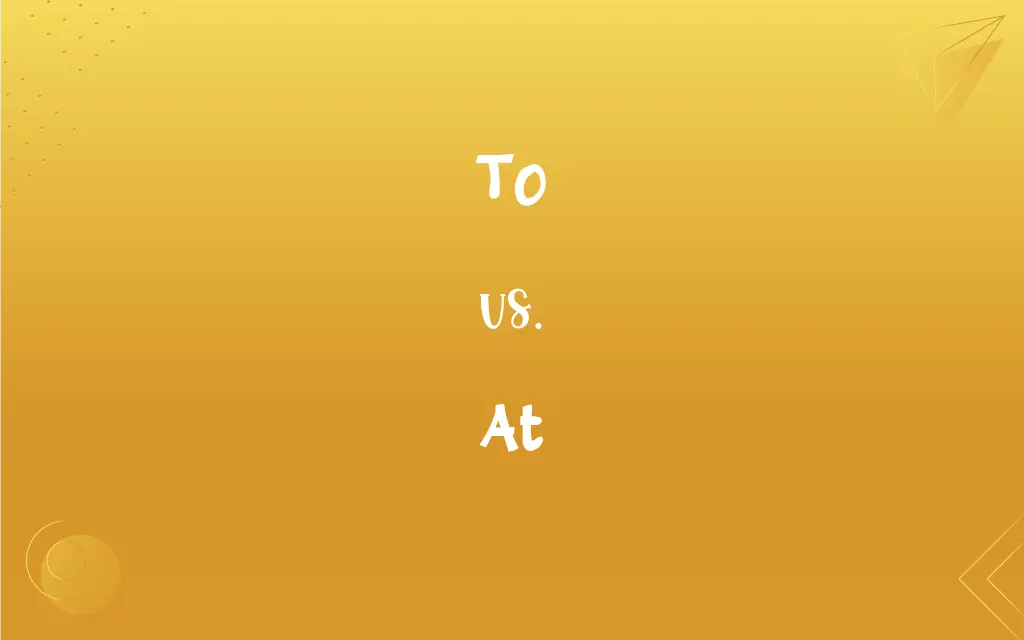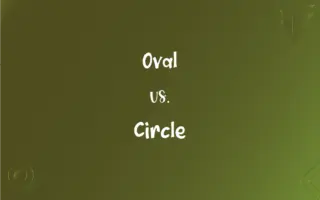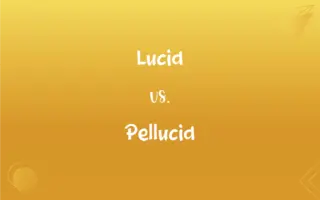To vs. At: What's the Difference?
Edited by Harlon Moss || By Janet White || Updated on November 21, 2023
'To' indicates movement towards a destination or end point, while 'at' denotes a specific location or point in time.

Key Differences
'To' is often used to express direction towards a place, person, or thing, suggesting movement or action. 'At', in contrast, is used to specify a particular point or location, indicating where something or someone is.
'To' can indicate the recipient of an action, showing the direction of an activity or gesture. 'At' is used to specify a point in time, indicating when an event occurs or is scheduled to occur.
In expressions of time, 'to' is used to indicate a range, leading up to a point, such as "five minutes to noon". 'At' is precise, used for exact times, such as "meet me at noon".
'To' can express purpose or intention, as in "went to the store to buy groceries". 'At' is used to reference specific activities or states, like "good at mathematics".
'To' also helps form the infinitive of verbs, such as "to read". 'At' can be used to indicate a specific condition or state, like "at peace".
ADVERTISEMENT
Comparison Chart
Basic Function
Indicates direction or movement towards
Denotes a specific location or point in time
Usage in Sentences
Shows recipient, direction, purpose
Specifies a precise location or time
Time Expressions
Used for ranges leading up to a point
Used for specific times or moments
Purpose and Intention
Expresses intention or reason for action
Indicates specific activities or states
Formation
Forms the infinitive of verbs
Used to reference conditions or states
ADVERTISEMENT
To and At Definitions
To
'To' indicates direction towards a place or person.
She is going to the market.
At
'At' denotes a specific location.
Meet me at the library.
To
'To' marks the recipient of an action.
He gave the book to his friend.
At
'At' is used in electronic communication addresses.
Contact me at [email protected]
To
'To' is used in time expressions approaching a point.
It's quarter to five.
At
'At' can indicate a specific condition.
He is at ease.
To
'To' expresses purpose or intention.
She went to the store to buy bread.
At
'At' is used to specify a point in time.
The meeting starts at 9 AM.
To
'To' forms the infinitive of a verb.
He loves to play soccer.
At
'At' indicates an activity or state.
She is good at painting.
To
In a direction toward so as to reach
Went to the city.
At
In or near the area occupied by; in or near the location of
At the market.
At our destination.
To
Towards
Turned to me.
At
In or near the position of
Always at my side.
At the center of the page.
To
Reaching as far as
The ocean water was clear all the way to the bottom.
At
To or toward the direction or location of, especially for a specific purpose
Questions came at us from all sides.
FAQs
Can 'to' express purpose?
Yes, 'to' can express purpose or intention.
What does 'to' indicate?
'To' indicates direction towards a destination or recipient.
Can 'at' indicate a state or condition?
Yes, 'at' can indicate a particular state or condition.
How is 'to' used in time expressions?
'To' is used in time expressions leading up to a point.
Can 'at' be used in email addresses?
Yes, 'at' (@) is used in electronic communication addresses.
Can 'to' indicate a range in time?
Yes, 'to' can be used to indicate a range, like "10 to 12".
How is 'at' used in the context of skills?
'At' is used to indicate proficiency in a skill, like "good at chess".
Can 'at' refer to specific moments?
Yes, 'at' can refer to specific moments, like "at midnight".
What does 'at' signify?
'At' signifies a specific location or point in time.
Is 'at' used for exact times?
Yes, 'at' is used for specifying exact times.
Is 'at' used for specific locations?
Yes, 'at' is used to denote a specific location.
How is 'at' used in addresses?
'At' is used in addresses to specify a particular place, like "at 123 Main St".
Is 'to' used to form infinitives?
Yes, 'to' is used to form the infinitive form of verbs.
Does 'to' show movement?
Yes, 'to' often shows movement towards something or someone.
Does 'to' have different meanings?
Yes, 'to' can have various meanings based on context, such as direction, purpose, or time.
Is 'at' versatile in usage?
Yes, 'at' is versatile, used for location, time, conditions, and more.
Can 'to' be used for recipients?
Yes, 'to' is often used to indicate the recipient of an action.
Is 'to' a preposition?
Yes, 'to' is commonly used as a preposition.
Can 'at' be a conjunction?
No, 'at' is not typically used as a conjunction.
Is 'to' used in comparisons?
'To' can be used in comparisons, like "similar to".
About Author
Written by
Janet WhiteJanet White has been an esteemed writer and blogger for Difference Wiki. Holding a Master's degree in Science and Medical Journalism from the prestigious Boston University, she has consistently demonstrated her expertise and passion for her field. When she's not immersed in her work, Janet relishes her time exercising, delving into a good book, and cherishing moments with friends and family.
Edited by
Harlon MossHarlon is a seasoned quality moderator and accomplished content writer for Difference Wiki. An alumnus of the prestigious University of California, he earned his degree in Computer Science. Leveraging his academic background, Harlon brings a meticulous and informed perspective to his work, ensuring content accuracy and excellence.































































